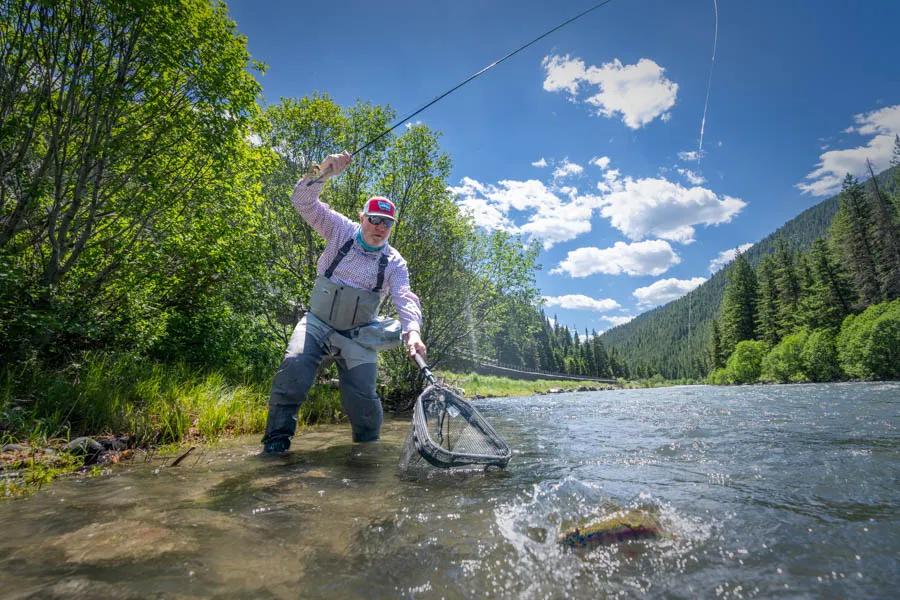
If there were one river in Montana that has just enough of everything--plenty of trout, a spectacular canyon, backcountry options, front-country accessibility, and some of the most consistent walk-and-wade fishing in Montana, the Gallatin River flowing from Yellowstone National Park near Big Sky and Bozeman, Montana is that Montana fly fishing trout stream. Montana is home to abundant fly fishing rivers and creeks and has some of the most talented fly fishing guides on the planet so folks there know a thing or two about what makes a good river. The Gallatin River is arguably the quintessential Montana fly fishing stream--and it is a local's favorite for anyone living-in or traveling-to Bozeman, Montana.
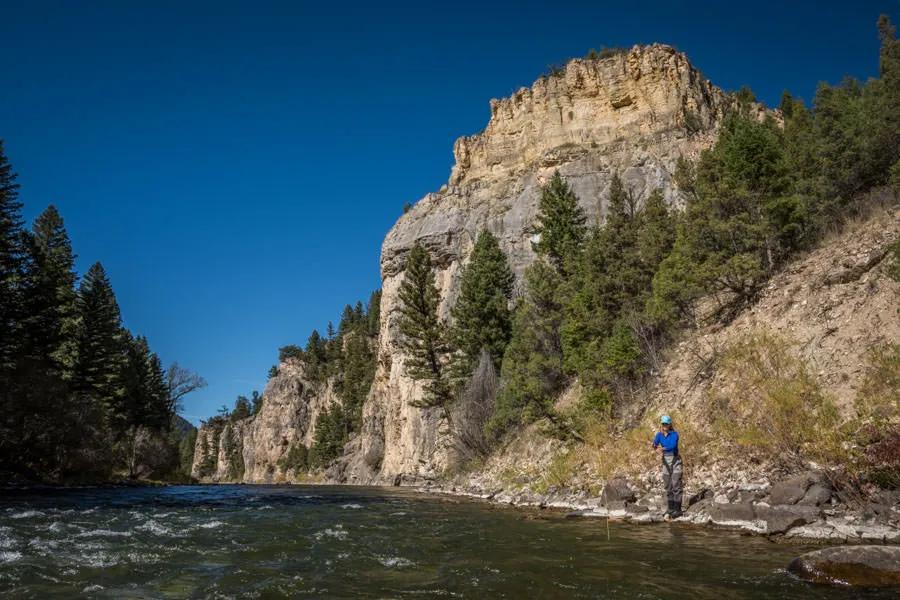
Overview of Fly Fishing on the Gallatin River
The Gallatin River begins in the high country in and around Yellowstone National Park. For this beautiful, freestone mountain river, its source in some of the most ruggedly beautiful is fitting. After it becomes a full fledged mountain stream, it flows out of the extreme northwest corner of Yellowstone National Park and joins with its major tributary, the Taylor Fork. From there it enters the Gallatin Canyon sections near Big Sky, where the fishing scenes from the movie A River Runs Through It were filmed. After exiting the canyon it enters the Gallatin Valley and becomes a meadow river lined with cottonwoods downstream to where it joins the Madison and Jefferson Rivers to make the Missouri River near Three Forks, Montana. The Gallatin is a very picturesque river with crystal clear water and lots and lots of trout. The river is not known for trophy trout like some of the other larger rivers in the area, but the beauty of this river and its high trout density make it a special Montana river for fly fishing. Because of the very high trout density, this river often produces fast action and high catch rates.
Anglers planning a fly fishing trip on the Gallatin River need to enjoy walk-and-wade fishing. For nearly all of its run, the Gallatin River is designated a wade fishing river only with the exception of the last few miles of the lower river. Trout densities and flows in the lower river are also not all that conducive for consistent fly fishing, so nearly all of fishing on the Gallatin River occurs in the canyon sections. The river's character changes dramatically throughout four distinct areas: inside Yellowstone National Park, the canyon sections near Big Sky, the Greater Gallatin Valley near Bozeman, and the lower reaches near its confluence with the Madison and Jefferson Rivers.

Hatches for Fly Fishing on the Gallatin River
The Gallatin River is known for a variety of large hatches. The salmonfly, the largest stonefly in Montana's rivers, is perhaps the star of the show on the Gallatin River. There may be some spring creeks and tailwaters that have more prolific hatches than the Gallatin, but no other river in Montana has the accessibility to fish these hatches as the Gallatin River. And, you wouldn't know it, but very few rivers in Montana have a season that last as long as the Gallatin River in the Gallatin Canyon near Big Sky--this is mostly due a few springs that flow into the river.
Trout can feed on the Gallatin River nearly every day of the year. Here is a quick breakdown of the hatches on the Gallatin River.
Midges (aka Chironomids)
Midges can provide the first early dry fly activity on the Gallatin River. Good midge fishing on the Gallatin River tends to occur on bluebird late winter or early spring days in February, March or early April.
Blue Winged Olives (aka Baetis or BWOs)
Blue Winged Olive mayflies hatch in spring and fall on the Gallatin River from the headwaters in Yellowstone National Park downstream to its confluence with the Madison and Jefferson Rivers, with the strongest hatches occurring in the Gallatin Canyon and the river just west of Bozeman. Beginning in late March and lasting through May and again in mid-September lasting well into October, these mayflies can hatch on any day during those two seasonal windows.
March Browns
The emergence of March Browns on the Gallatin is sporadic. However, they begin to hatch on the entire length of the river in mid- April and can be seen throughout May. Conditions must be ideal—overcast, water temperatures between 43 and 47 degrees F, and light winds.
Caddis
Caddis, and one hatch in particular—the Mother’s Day caddis hatch—are famous on the Gallatin River. An abundance of caddis species live in the Gallatin and attempting to name them all would be cumbersome and mind-blowing. The famous Mother’s Day caddis hatch on the Gallatin River can begin in late April, but most years the hatch begins around its namesake. However, river conditions and the ability to fish the hatch depend when snowmelt runoff will begin.
Salmonflies
In most years, hatches of salmonflies are abundant. However, unlike the salmonfly hatches on the Madison or Yellowstone Rivers, fishing the salmonfly hatch on the Gallatin River is a little more challenging. Because the Gallatin River is primarily a walk-and-wade fishery--fishing from boats is prohibited for most of its run--anglers fishing the salmonfly hatch on the Gallatin River need to be strong waders and exercise extreme caution during the high flows that are so common during the salmonfly hatch on the Gallatin River.

Golden stoneflies
On the Gallatin River, golden stoneflies provide plenty of action for dry fly anglers. These large—size 8 to 12—aquatic insects emerge slightly later than salmonflies. Beginning in mid or late June and lasting into mid-July, a golden stonefly hatch occurs in the same sequence as a salmonfly hatch, however golden stoneflies are smaller.
Yellow Sally stoneflies
These stoneflies may hatch concurrently with salmonflies and Golden stoneflies. Often mistaken for caddis or PMDs this small stonefly is a crucial part of a Gallatin River trout’s diet. Yellow Sally stonefly nymphs become active in mid June, with adult insects hatching from late-June well into early August.
Spruce Moths
Much of the Gallatin River's run is in the Gallatin River Canyon near Big Sky. With abundant pine trees, there are abundant spruce moths that hatch. The spruce moths begin to emerge in early July but in some years their strongest emergence is during early August. Although this can be a strong hatch and the trout can gorge themselves without reserve, year-in and year-out, it is an unreliable hatch to plan around.
Pale Morning Duns
An abundant mayfly for the entire run of the Gallatin River, hatches of Pale Morning Duns (PMDs) begin in mid or late June and last all through July. Primarily found in the river’s riffles and longer runs, PMDs emerge when water temperatures hit 58 degrees F.
Trico mayflies
These small mayflies are primarily important for dry fly anglers who enjoy casting very tiny flies—sizes 18 to 22—to rising trout. Tricos hatch at sunrise and an emergence rarely lasts longer than a few hours. Trico mayflies hatch from bankside structure or in riffles.
Terrestrials: Grasshoppers, ants, and beetles
On the Gallatin River as summer moves on, hatches become more sporadic and less predictable. Grasshoppers, ants, and beetles dominate a trout’s diet by late July. Having been blown into the river these land-dwelling insects are a common occurrence on the Gallatin River.
October caddis
These late season caddis are exciting to see, however, their emergence is sporadic. October caddis on the Gallatin River can hatch as early as late September and will typically peak in late October.

Sections for Fly Fishing on the Gallatin River
The Gallatin River feels like it was created for the fly fishing angler in mind. It begins as a small, intimate mountain stream flowing through meandering meadows before leaving Yellowstone National Park and entering the canyon sections near Big Sky. From there downstream to Gallatin Valley and the Bozeman area the river is a classic pocket-water, riffle-run stream filled with mostly opportunistic trout. Once leaving the Gallatin Canyon the river takes on the feel of the lower Yellowstone River but much smaller. Access points in Gallatin Valley are few and far between and flows often become very low in summer due to irrigation demand. Because of this, nearly all of the focus on the Gallatin River occurs upstream of Gallatin Valley.
Gallatin River in Yellowstone National Park
The Gallatin River begins as a small stream deep in the heart of Yellowstone National Park. The river comes from a cirque lake several miles off the nearest road. Fishing is best several miles from the source where it takes the characteristics of one Yellowstone National Park's many quintessential meandering meadow streams. The stream parallels US Highway 191 from the meadow down offering easy access by car for several miles. Excellent wildlife including bears, moose, and deer are occasionally viewed along the banks.
Gallatin River from Yellowstone Park Boundary to Spanish Creek/Mouth of Gallatin Canyon
Locals call this section the Gallatin Canyon. Here the river is home to flowing pocket water, riffles, runs, and pools surrounded by aromatic alpine forests; frequent moose crossings, and excellent hatches. It is no wonder they selected this portion for scenes in the movie "A River Runs Through It." The Gallatin Canyon is busy with anglers throughout the year and the most noticeable once the RV traffic arrives in July and August. Excellent nymphing and solid hatches of Blue-Winged Olive mayflies begin in mid-spring and then amp up again post run-off with Pale Morning Duns providing fantastic dry fly opportunities for aggressive rainbows. Fortunate anglers may experience thick hatches of salmonflies and golden stoneflies, if high water after snowmelt runoff doesn't make the river unfishable and unsafe. Every few years, cyclic infestations of terrestrial spruce moths also bring fanatical trout to the surface late July through mid August while the moths fly toward the bright reflection of the river's surface--much like moths dive bombing your porch light. If you are fortunate to be in the right place at the right time, the spruce moth hatch on the Gallatin River can truly be unforgettable.
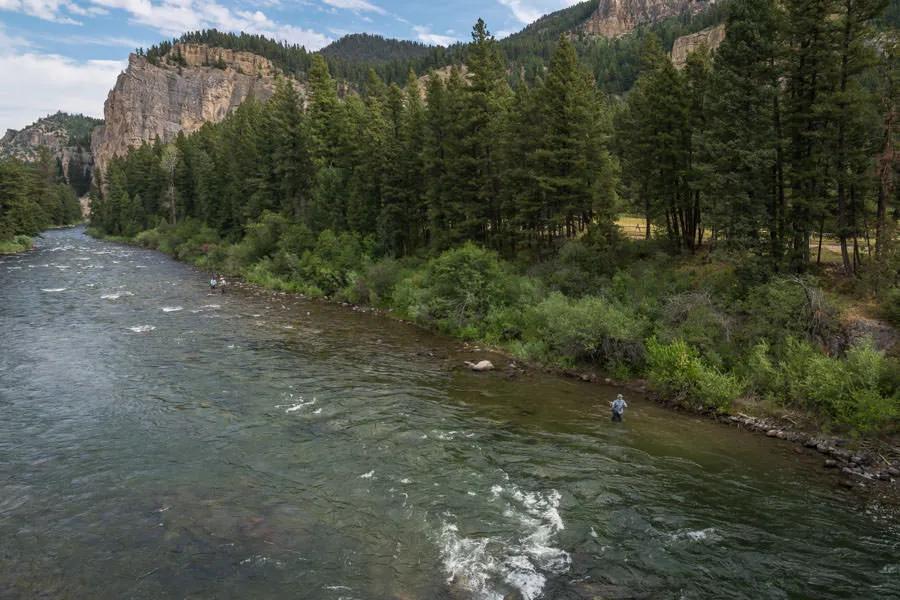
Gallatin River from Spanish Creek to its Confluence with the East Gallatin River
The river suddenly changes character as it exits the alpine canyon and flows through the wide agricultural valley, also known as the Greater Gallatin Valley, which is home to nearby Bozeman, Montana. Hay fields and cottonwoods dominate the shoreline of the river as it braids repeatedly forming riffles, islands, and long deep pools. Wading access is available at a few locations, roughly every 8 miles or so, but that means anglers here need to put in a little sweat equity and also know the Montana Stream Access Law and adhere to it. This section fishes consistently well although agricultural dewatering limits the river's potential. The average size of the trout increases and browns become more prominent the further downstream you get. Trout numbers drop and fish tend to be more spread out depending on the volume of flow and available holding water.
Gallatin River from the Confluence with the East Gallatin to Headwaters State Park
The lower Gallatin River forms when the East Gallatin joins the main steam near Manhattan. The river then terminates at the confluence of the mighty Missouri River alongside the Madison and Jefferson Rivers near the town of Three Forks, Montana. The lower Gallatin River does have some large trout that make there way up from the Missouri river. Float fishing from a drift boat is allowed on the last 12 miles and this section. Although the fish counts are lower than farther upstream, the potential for trophy fish keep some local Montana fly fishing guides fishing interested in the lower Gallatin River. Catch rates in this section are some of the lowest in the region so many anglers opt for other nearby float-fishing options like the Madison or Missouri Rivers.
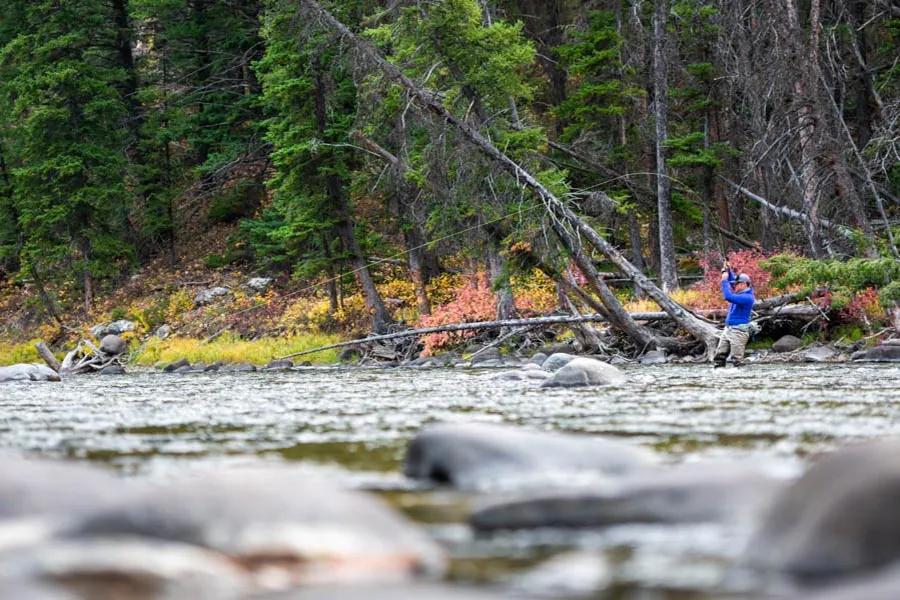
Seasons for Fly Fishing the Gallatin River
The Gallatin River is one of the most consistent year-round fisheries for all of the Montana rivers for fly fishing. However, because the Gallatin River flows for nearly 100 miles, it has a variety of characteristics. Because the fish counts and catch rates are the highest in the sections upstream of Gallatin Gateway and into Yellowstone National Park, these guidelines are for the Gallatin River above the town of Gallatin Gateway, near Big Sky, and into the Yellowstone National Park, which is by far the most popular stretch--and for good reason because it has the highest concentrations of fish.
Spring (March - May)
The spring fishing on the Gallatin River can be fickle and is really dependent on weather. Look for warm sunny days in March to energize the fish between 11am and 3pm. Girdle bugs, little golden stones, midges, baetis nymphs, attractor nymphs, worms, and eggs are all productive. Warm overcast days are excellent for Blue Winged Olive hatches usually starting by late March or early April. Be sure to bring a variety of size 18 baetis nymphs, emergers, and duns. Many fly fishing guides favorite days are warm fronts later in spring, which bring light drizzle and temperatures in the mid to high 50's. These days typically bring consistent Blue Winged Olive hatches in the afternoon and exciting dry fly fishing to follow. If at all possible, avoid fishing during the coldest of cold fronts.
Run off (mid/late May - early June)
The Gallatin River drains a lot of real estate, much of which is covered by deep snow pack throughout the winter. The river is best left for whitewater enthusiasts at this time. If you have the itch and are watching the gauges, an adventurous angler can successfully pull fish during runoff with large heavy stonefly nymphs and San Juan Worms fished tight to boulders and side eddies after the river crests and begins to subside. You'll have better success if you wait for the water clarity to exceed at least a foot.
Summer and Early Fall (mid/late June - September)
Fishing the Gallatin River can be excellent this time of year, with the best fishing after run-off. Hatches of salmonflies and golden stones often occur immediately after run-off peaks. Casting size 6-8 dry flies in pocket water, tight to the bank, and boulder-eddies is quite productive. The stonefly hatches will typically be concentrated in a stretch of a few miles. Be sure to move up and down the river when you're around the hatch in order to fish different phases of the life cycle. Hatches of caddis and PMD's are thick in July and follow the stoneflies. Anglers will find caddis on sunny days and thick PMD's on cloudy afternoons, and Western drakes are sometimes reported in the Yellowstone National Park section of the Gallatin River in July.
Attractor dries work great once the main hatches begin to draw to a finish around mid July. Fishing the Gallatin River until dark using Elk Hair Caddis and attractor dries can be very memorable. By mid July, the RV's have arrived in full force and begin to pressure many of the beautiful holes within sight of the road. Don't be shy about walking away from the highway access points, fishing pocket water, and throwing terrestrial dries in the afternoon.
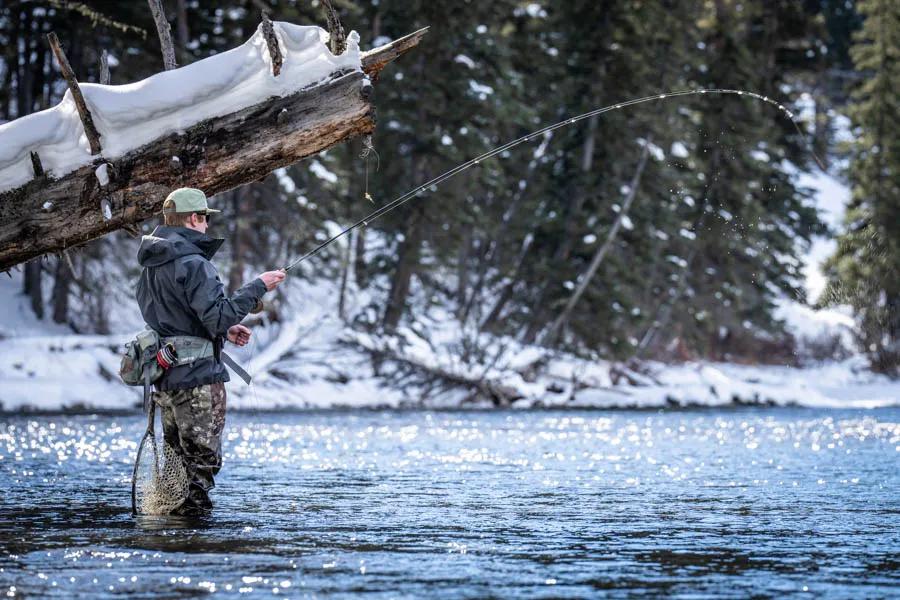
Late Fall (October - November)
Fish can be spooky and selective in the low gin clear water that is so common on the Gallatin River in late fall. Many anglers are focused on the excellent fishing opportunities occurring elsewhere on larger rivers in the region. Other local anglers simply hang up their fly rods in lieu of elk and pheasant season. Minimal crowds and consistent Blue Winged Olive hatches on cloudy afternoons can be quite fun. That paired with many anglers fishing elsewhere, the Gallatin River in October and November can be surprisingly good place to find solitude.
Winter (December - March)
The Gallatin River can fish quite well in winter....in one specific area: downstream of the Big Sky into Gallatin Canyon. Several springs warm the river and keep it ice free while also congregating fish. Typical winter fishing strategies apply, such as fishing during the warmest hours on sunny days with midge imitations. The effect of these springs is no secret though, so take a number and wait for the best holding water.
